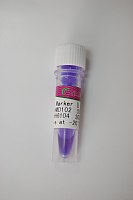Construction of Recombinant Vaccinia Viruses Using Leporipoxvirus-Catalyzed Recombination and Reactivation of Orthopoxvirus DNA
互联网
522
Poxvirus DNA is not infectious because the initiation of the infective process requires proteins encapsidated along with the virus genome. However, infectious virus can be produced if purified poxvirus DNA is transfected into cells previously infected with another poxvirus. This process is termed heterologous reactivation if the infecting virus is different from the transfected virus. We describe a method in which the high-frequency recombination and replication reactions catalyzed by the Leporipoxvirus, Shope fibroma virus (SFV), can be coupled with SFV-promoted reactivation reactions to rapidly construct recombinant vaccinia viruses in high yields (25–100% recombinant progeny). The reactivated vaccinia viruses are easily purified free of the SFV helper virus by plating mixed populations of virus on cells that support only the growth of vaccinia virus. These heterologous reactivation reactions can be used to manipulate the structure of virus genomes and produce viruses that express recombinant proteins at high levels. We illustrate the method by polymerase chain reaction (PCR) cloning the gene encoding green fluorescent protein (GFP), then using double-strand break repair reactions to produce a recombinant virus that expresses high levels of GFP.






